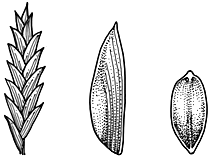Cyperus nutans subsp. eleusinoides (Kunth) T.Koyama APNI* Synonyms: Cyperus eleusinoides Kunth APNI*
Cyperus nutans var. eleusinoides (Kunth) Haines APNI*

Description: Tall perennial with short thick rhizome.
Culms triquetrous, smooth, to 1 m high, to 10 mm diam.
Leaves not septate-nodulose, shorter than culms, 6–12 mm wide. Inflorescence compound with 6–10 primary branches to 30 cm long, suberect; spikes narrow-cylindrical, 2–3 cm long, c. 5 mm diam.; involucral bracts leaf-like, 4–6 much exceeding inflorescence. Spikelets flattened, 15–25 per spike, ± appressed to rachis, 6–14 mm long, 1.5–2 mm wide in side view, 8–14-flowered; rachilla winged, persistent. Glumes obtuse, short-mucronate (mucro to 0.2 mm long), with sides 2- or 3-nerved, 2–2.5 mm long, pale red-brown with broad white or yellowish margins. Stamens 3. Style 3-fid.
Nut triquetrous, narrow-ellipsoid to narrow-obovoid, two-thirds as long as glume, 1.0–1.3 mm long, 0.4–0.6 mm diam., dark brown.
Flowering: summer.
Distribution and occurrence: Grows on creek banks; collected once near Kyogle.
NSW subdivisions: NC
Other Australian states: Qld N.T.
Text by KL Wilson (1993)
Taxon concept: Flora of NSW vol 4 (1993)
| The single subspecies in NSW. Characters and distribution as for the species in NSW. |
APNI* Provides a link to the Australian Plant Name Index (hosted by the Australian National Botanic Gardens) for comprehensive bibliographic data
***The AVH map option provides a detailed interactive Australia wide distribution map drawn from collections held by all major Australian herbaria participating in the Australian Virtual Herbarium project.
|


